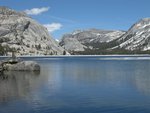Although not as newsworthy as those of recent years, many significant rock falls occurred in Yosemite in 2011. Probably the most spectacular rock falls originated from the north face of Middle Cathedral rock in July. Three distinct rock falls occurred over a period of several weeks, with a total volume of about 120 cubic meters (about 325 tons). Witnesses in El Capitan Meadow captured impressive photos of the falls and subsequent dust clouds. Fortunately rock debris was contained to the talus slope beneath the cliff and did not affect nearby trails or roads. The Middle Cathedral rock falls occurred during very warm conditions and may have been triggered by thermal stresses. Ongoing monitoring by the National Park Service and U.S. Geological Survey indicates that air temperatures can cause partially-detached rock flakes to deform substantially on both daily and annual timescales.
Another area of notable rock falls in 2011 was Yosemite Falls. On 10 September 2011 a rectangular boulder 2 cubic meters in volume (6 tons) fell from below the upper Yosemite Falls Trail, shattered on a bedrock slab, and fell into the Lower Yosemite Falls amphitheater. Small rock fragments landed in the vicinity of the Lower Yosemite Falls footbridge, but there were no reported injuries. A second and much larger rock fall occurred on 28 October 2011, originating from near the lip of Upper Yosemite Falls. This block, about 20 cubic meters in volume (55 tons), fell from beneath an overhanging roof, skimmed the cliff, and then shattered on impact with the bedrock at the base of the upper falls. Off-trail hikers were present at the base of the falls but avoided injury.
The two most consequential rock falls in 2011 affected park roads. The largest event was not a true rock fall but rather a mass of broken rock and soil that slid onto Foresta Road between Old El Portal and Rancheria during the heavy rain and snow in late March 2011. The volume of this slide was about 1,200 cubic meters (about 3,200 tons). Foresta Road was closed for several weeks as the slide was cleared, and is presently closed again to accommodate engineering of the slope to reduce future slide potential. In the early morning of 7 November 2011, a large boulder (about 18 cubic meters, or 50 tons) and several smaller boulders tumbled from the north wall of the Merced Gorge just east of Arch Rock and embedded themselves in the El Portal Road. Following assessment of the source area, the boulders were removed and the road repaired in time for the morning commute into Yosemite Valley.
Other areas in Yosemite experiencing rock falls in 2011 include Royal Arches, Ahwiyah Point, Half Dome, Glacier Point, the Rockslides, and Hetch Hetchy. In all, there were 53 documented rock falls in 2011, with an approximate cumulative volume of 2,200 cubic meters (6,000 tons). This volume is comparable to the volume that fell in 2010 (2,900 cubic meters) but much smaller than what fell in 2009 (some 50,000 cubic meters); the volume in 2009 was dominated by the large Ahwiyah Point rock fall. Our database of rock falls and other geologic events in Yosemite, begun in 1857, now documents nearly 900 events, making it one of the longest and most detailed landslide databases in the world.
It is very likely that there were additional rock falls in 2011, but these events either were not witnessed or went unreported. If you witness a rockfall of any size, encounter fresh rock debris, or hear cracking or popping sounds emanating from the cliffs, please contact park geologist Greg Stock at (209) 379-1420, or at greg_stock@nps.gov, or contact Park Dispatch by dialing 911 within the park. Predicting rock falls is not yet possible, but understanding the events that do happen is an important step toward this goal. For more information on rock falls and rock fall research in Yosemite, please see the Park’s web page: http://www.nps.gov/yose/naturescience/rockfall.htm.
Yosemite Rock Fall Year in Review: 2011
All posts are those of the individual authors and the owner
of this site does not endorse them. Content should be considered opinion
and not fact until verified independently.
Sorry, only registered users may post in this forum.


